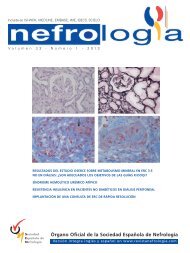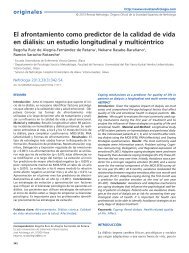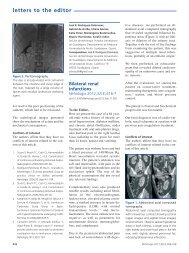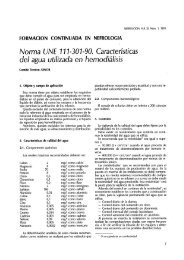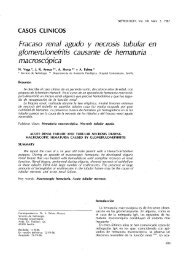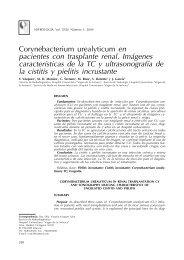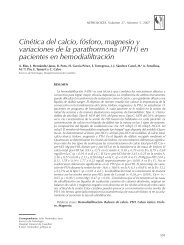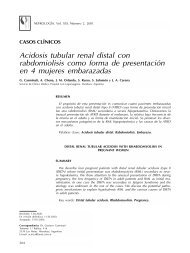PDF Número - NefrologÃa
PDF Número - NefrologÃa
PDF Número - NefrologÃa
You also want an ePaper? Increase the reach of your titles
YUMPU automatically turns print PDFs into web optimized ePapers that Google loves.
cartas al director<br />
resolved after catheter removal.<br />
The patient, a 70-year-old man with<br />
chronic renal failure and class III heart<br />
failure was admitted to the hospital on<br />
26 July 2010 with turbid peritoneal<br />
dialysate, non febrile, having mild<br />
abdominal pain and positive Rebound<br />
sign at the physical examination.<br />
Leucocyte cell count showed the<br />
presence of 1200 leucocytes/µl<br />
(neutrophil count of 90%) in the<br />
peritoneal dialysate but subsequent<br />
culture of the fluid resulted negative.<br />
Treatment started with vancomycin<br />
15mg/kg/5 days i.p. and aztreonam<br />
2gr/d i.p. for a total of 20 days. On 30<br />
July 2010 cell count was 50<br />
leucocytes/µl and the patient was<br />
discharged.<br />
3 days later however, at the first control<br />
visit, the peritoneal dialysate was turbid<br />
anew, the patient presented the same<br />
clinical findings and cell count revealed<br />
the presence of 300 leucocytes/µl. A<br />
Gram positive, spherical microorganism<br />
that occurred in tetrads with circular,<br />
smooth, glistering and yellow colonies<br />
was recovered from the peritoneal<br />
dialysate. The microorganism was<br />
identified as Kocuria varians by the<br />
VITEK 2 system. The isolate was<br />
susceptible to gentamycin, erythromycin,<br />
clindamycin, tetracycline, glycopeptides<br />
and linezolid while it was resistant to<br />
levofloxacin by the disc diffusion<br />
method. Following laboratory report, the<br />
patient was treated with vancomycin<br />
alone (15mg/kg/5 days i.p. for a total of<br />
20 days).<br />
Turbidity of the peritoneal dialysate<br />
did not reappear until 27 August 2010<br />
when the patient was admitted to the<br />
hospital with generalized abdominal<br />
pain, positive Rebound sign and cell<br />
count of 550 leucocytes/µl. K. varians<br />
was isolated for the second time and<br />
removal of the peritoneal catheter<br />
followed by insertion of a new one in a<br />
different position was considered.<br />
Culture of the removed catheter was<br />
positive for K. varians. Vancomycin<br />
i.p. was administered, subsequent<br />
cultures were negative and the patient<br />
remained in good clinical condition<br />
since then.<br />
Infections related to K. varians are<br />
uncommon but this species may act as<br />
opportunistic pathogen in<br />
immunocompromised patients with<br />
underlying diseases. Furthermore, K.<br />
varians is a biofilm forming bacterium 4<br />
thus probably complicating the<br />
antimicrobial treatment of catheter<br />
related infections. Erroneous<br />
identification of coagulase-negative<br />
Staphylococci as Kocuria spp. is<br />
possible and can be excluded with<br />
certainty only with the application of<br />
genotypic assays such as 16S RNA. 1 In<br />
the present case the Vitek 2 system<br />
using the new GP identification card 5<br />
reported a “very good identification”<br />
for all three isolations. This case report<br />
aims on emphasizing the importance of<br />
careful consideration of the laboratory<br />
and clinical procedures when rarely<br />
pathogenic microorganisms are<br />
isolated in the peritoneal dialysate of<br />
patients undergoing CAPD.<br />
Conflicts of interest<br />
The authors declare that there is no<br />
conflict of interest associated with this<br />
manuscript.<br />
1. Stackebrandt E, Koch C, Gvozdiak O,<br />
Schumann P. Taxonomic dissection of<br />
the genus Micrococcus: Kocuria gen.<br />
nov., Nesterenkonia gen. nov.,<br />
Kytococcus gen. nov., Dermacoccus gen.<br />
nov., and Micrococcus Cohn 1872 gen.<br />
emend. Int J Syst Bacteriol 1995;45:682-<br />
92.<br />
2. Ben-Ami R, Navon-Venezia S, Schwartz<br />
D, Schlezinger Y, Mekuzas Y, Carmeli Y.<br />
Erroneous reporting of coagulasenegative<br />
Staphylococci as Kocuria spp.<br />
by the Vitek 2 system. J Clin Microbiol<br />
2005;43:1448-50.<br />
3. Tsai CY, Su SH, Cheng YH, Chou YL, Tsai<br />
TH, Lieu AS. Kocuria varians infection<br />
associated with brain abscess: A case<br />
report. BMC Infect Dis 2010;10:102.<br />
4. Midelet G, Kobilinsky A, Carpentier B.<br />
Construction and analysis of fractional<br />
multifactorial designs to study<br />
attachment strength and transfer of<br />
Listeria monocytogenes from pure or<br />
mixed biofilms after contact with a solid<br />
model food. Appl Environ Microbiol<br />
2006;72:2313-21.<br />
5. Boudewijns M, Vandeven J, Verhaegen J,<br />
Ben-Ami R, Carmeli Y. Vitek 2 automated<br />
identification system and Kocuria<br />
kristinae. J Clin Microbiol 2005;43:5832.<br />
Georgios Meletis 1 , Vasiliki Gogou 1 ,<br />
Maria Palamouti 1 , Petros Spiropoulos 2 ,<br />
Kiriaki Xanthopoulou 2 , Paraskevi Tantou 1 ,<br />
Artemisia Rizou 1 , Vasileios Thomoglou 1<br />
1<br />
Department of Clinical Microbiology.<br />
Veroia G. Hospital. Veroia (Greece).<br />
2<br />
Nephrology Department.<br />
Veroia G. Hospital. Veroia (Greece).<br />
Correspondence: Georgios Meletis<br />
Department of Clinical Microbiology.<br />
Veroia G. Hospital, Veroia, Greece.<br />
meletisg@hotmail.com<br />
Enfermedad de Paget<br />
poliostótica<br />
asintomática asociada<br />
a hiperparatiroidismo<br />
secundario en un<br />
paciente en diálisis<br />
peritoneal<br />
Nefrologia 2012;32(4):542-4<br />
doi:10.3265/Nefrologia.pre2012.Apr.11477<br />
Sr. Director:<br />
La enfermedad ósea de Paget (EP) es un<br />
trastorno focal del remodelado óseo que<br />
puede afectar a uno o más huesos 1 . Es la<br />
segunda patología ósea más frecuente después<br />
de la osteoporosis y su diagnóstico en<br />
la mayoría de los casos se realiza mediante<br />
una bioquímica rutinaria, donde se aprecia<br />
elevación de la fosfatasa alcalina (FA),<br />
o en estudios de imagen realizados por<br />
otros motivos 1-3 .<br />
Su incidencia en pacientes con enfermedad<br />
renal crónica (ERC) es desconocida.<br />
Pocos han sido los casos comunicados en<br />
la literatura 4-8 , y en algunos de ellos la presencia<br />
de EP se ve enmascarada por la presencia<br />
de hiperparatiroidismo secundario<br />
(HPS) 4-6 , lo que dificulta su diagnóstico. En<br />
542 Nefrologia 2012;32(4):535-54



